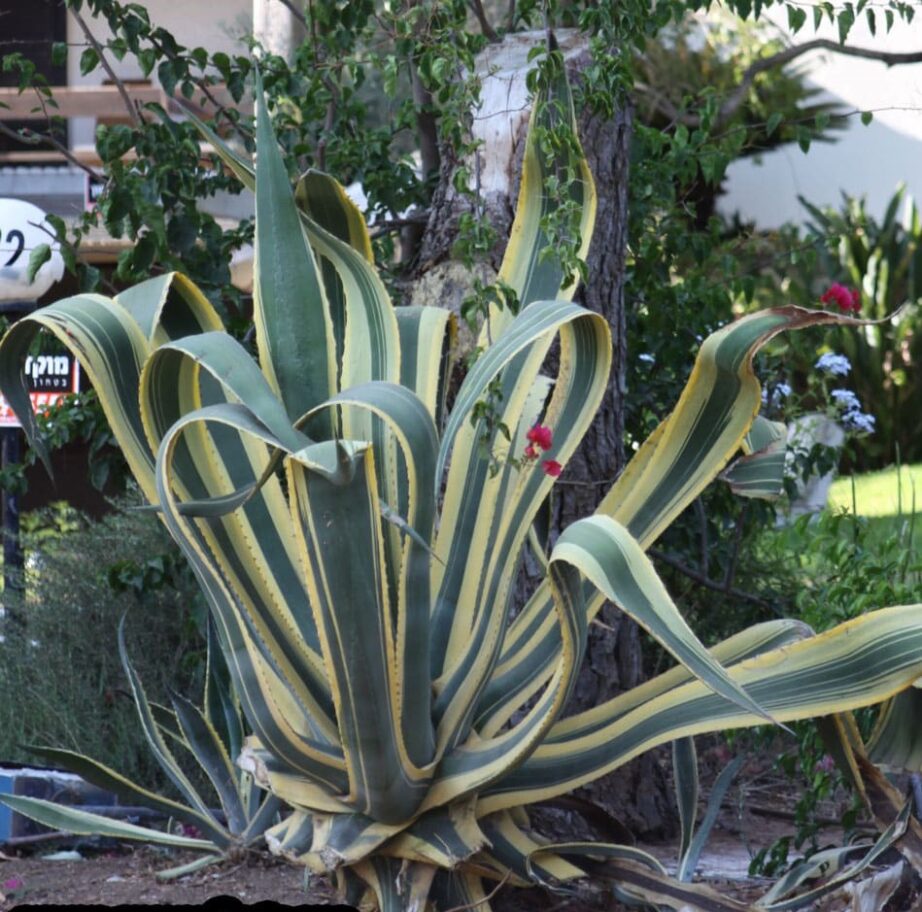I have some larger plants as well as small pups & seeds 4 sale . ASK.

Agave americana, common names century plant, maguey, or American aloe, is a species of flowering plant in the family Asparagaceae, native to Mexico and the United States in Texas. It is cultivated worldwide as an ornamental plant, and has been naturalized in many regions, including parts of the West Indies, South America, Mediterranean Basin, Africa, Canary Islands, India, China, Thailand, and Australia.

Despite the common name “American aloe”, it is not in the same family as aloe, though it is in the same order, Asparagales.
Although it is called the century plant, it typically lives only 10 to 30 years. It has a spread around 1.8–3.0 m (6–10 ft) with gray-green leaves of 0.9–1.5 m (3–5 ft) long, each with a prickly margin and a heavy spike at the tip that can pierce deeply. Near the end of its life, the plant sends up a tall, branched stalk, laden with yellow blossoms, that may reach a total height up to 8–9 m (25–30 ft)

Its common name derives from its semelparous nature of flowering only once at the end of its long life. The plant dies after flowering, but produces adventitious shoots from the base, which continue its growth.
A. americana is cultivated as an ornamental plant for the large dramatic form of mature plants—for modernist, drought-tolerant, and desert-style cactus gardens—among many planted settings. It is often used in hot climates and where drought conditions occur. The plants can be evocative of 18th-19th-century Spanish colonial and Mexican provincial areas in the Southwestern United States, California, and xeric Mexico. It is also a popular landscape plant in dry beach gardens in Florida and coastal areas of the Southeastern United States.

When grown as a house plant, A. americana is tolerant of light levels ranging from direct sunlight to shade and requires little watering. It does require a winter resting period at temperatures around 10 to 12 °C (50 to 54 °F). It should be grown in a very porous, sandy potting soil, allowed to dry out between waterings, and repotted every spring.
Uses

Tools used to obtain agave’s ixtle fibres, at the Museo de Arte Popular, Mexico City, D.F.
Cuisine

If the flower stem is cut before flowering, a sweet liquid called aguamiel (“honey water”) gathers in the hollowed heart of the plant. This can be fermented to produce the alcoholic drink called pulque or octli in pre-Columbian Mexico.
In the tequila-producing regions of Mexico, agaves are called mezcales. The high-alcohol product of fermented agave distillation is called mezcal; A. americana is one of several agaves used for distillation. A mezcal called tequila is produced from Agave tequilana, commonly called “blue agave”.

The many different types of mezcal include some which may be flavored with the very pungent mezcal worm. Mezcal and tequila, although also produced from agave plants, are different from pulque in their technique for extracting the sugars from the heart of the plant, and in that they are distilled spirits. In mezcal and tequila production, the sugars are extracted from the piñas (or hearts) by heating them in ovens, rather than by collecting aguamiel from the plant’s cut stalk. Thus, if one were to distill pulque, it would not be a form of mezcal, but rather a different drink


Agaves are also found throughout Latin America, and are used similarly. In Ecuador, the analog of pulque is guarango, and more recently this has been distilled as miske.
Agave nectar is marketed as a natural form of sugar with a low glycemic index that is due to its high fructose content.
Fibres

The leaves yield fibres, known as pita, which are suitable for making rope, nets, bags, sacks, matting, or coarse cloth. They are also used for embroidery of leather in a technique known as piteado. Both pulque and maguey fibre were important to the economy of pre-Columbian Mexico.
Medicine

Agave americana contains agavose, a sugar with the same chemical formula of sucrose (C12H22O11[24]), but with only 0.32 of its sweetening power, as well as agavasaponins and agavosides.[25] It is used in traditional medicine to treat several ailments,[26] and as a laxative, diuretic and diaphoretic,[27] although a systematic review did not find enough data to support its effectiveness or safety.[28] A. americana is known to be able to cause severe allergic dermatitis.
 Any questions or if buying, contact me HERE
Any questions or if buying, contact me HERE
![]()

